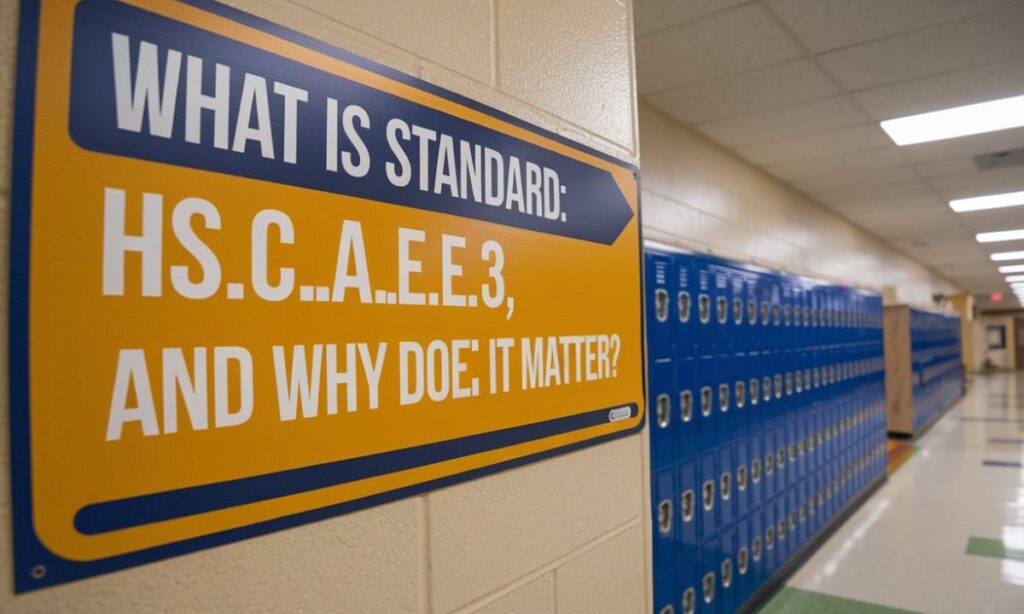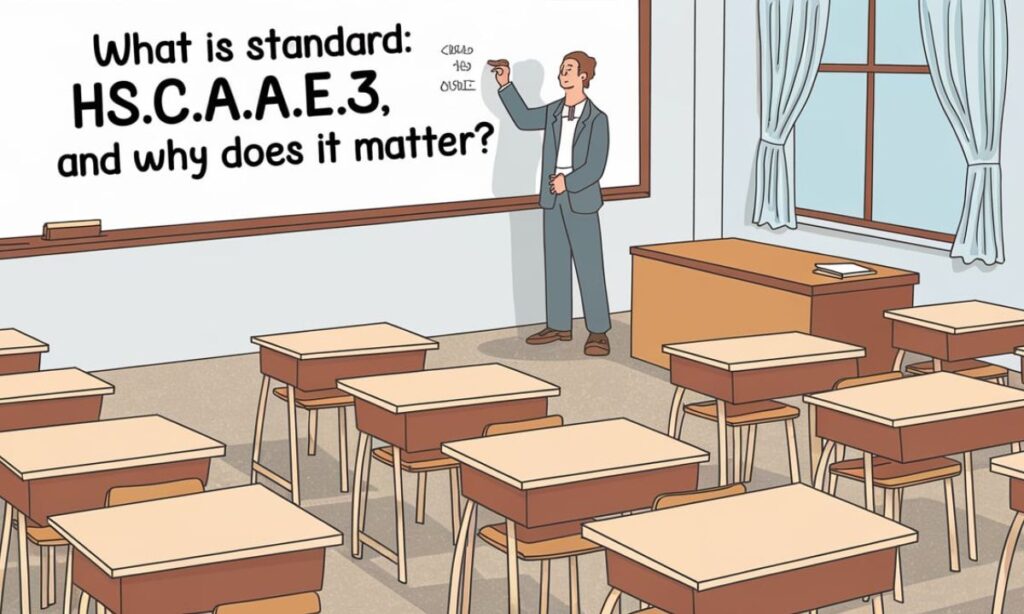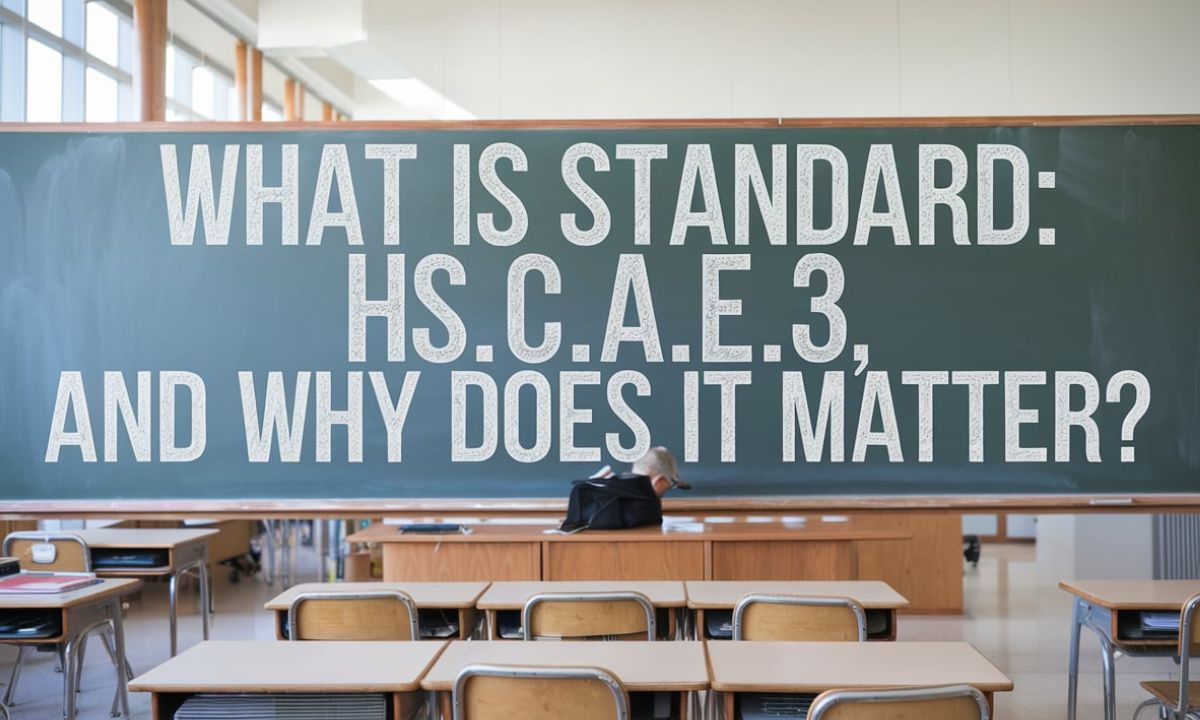Standard: HS.C.A.E.3 plays a vital role in shaping high school students’ critical thinking and analytical skills. This standard focuses on evidence-based reasoning and equips students to solve real-world problems effectively.
It integrates interdisciplinary learning, preparing students for college, careers, and life beyond the classroom. By mastering HS.C.A.E.3, students develop essential reasoning and articulation skills.
What Does Standard: HS.C.A.E.3 Actually Cover?

Standard: HS.C.A.E.3 emphasizes evidence-based learning strategies and critical thinking in education. It requires students to:
- Analyze and evaluate data and arguments.
- Develop proof-based arguments.
- Make logical connections across subjects.
- Apply analytical reasoning skills to solve problems.
The standard encourages students to think critically and articulate their reasoning with clarity and precision.
Focus on Evidence-Based Thinking
Evidence-based thinking is a cornerstone of Standard: HS.C.A.E.3. It involves:
- Collecting and interpreting data.
- Drawing conclusions supported by reliable evidence.
- Refining ideas through research and analysis.
Benefits ohttps://techyspirtz.com/theboringmagazinecom-where-engaging-content/f Evidence-Based Thinking
| Skill | Description | Example |
| Analytical reasoning | Breaking down complex problems | Analyzing a historical event’s causes |
| Data-driven decision-making | Using evidence to make informed choices | Designing a science experiment |
| Proof-based argumentation | Supporting claims with evidence | Writing a persuasive essay |
A Real-Life Example:
Imagine a high school science project where students must design an eco-friendly product. Using Standard: HS.C.A.E.3, students:
- Research environmental data.
- Develop a hypothesis based on evidence.
- Create a prototype and test it.
- Present their findings with supporting data.
This process mirrors real-world problem-solving and prepares students for challenges they may face in future careers.
Connecting Ideas Across Subjects
Standard: HS.C.A.E.3 fosters interdisciplinary connections in learning. For example:
- Math and Science: Applying mathematical models to scientific experiments.
- History and Literature: Analyzing historical contexts in literary works.
- STEM and Humanities: Using logical reasoning in both technical and creative fields.
By connecting ideas across subjects, students develop a holistic understanding of concepts and their applications.
Practical Scenario:
Task: Analyze Climate Change Data
Objective: Students evaluate global climate data to understand environmental trends.
Steps:
- Gather temperature and carbon emission data.
- Use analytical reasoning to identify patterns.
- Develop an argument about the effects of human activities.
- Propose evidence-based solutions.
This activity not only enhances critical analysis but also emphasizes the application of evidence in education.
Preparing for Life Beyond the Classroom

Standard: HS.C.A.E.3 prepares students for real-world scenarios by developing:
- Logical reasoning in classroom tasks.
- Skills for college and career readiness.
- Cross-subject integration in learning.
By mastering these skills, students are equipped to tackle future challenges with confidence and competence.
Why It Matters:
Read This blog https://commonlifestyle.co.uk/2024/12/19/what-is-standard-hs-c-a-e-3-and-why-does-it-matter/
The importance of Standard: HS.C.A.E.3 lies in its ability to:
- Foster critical analysis in high school studies.
- Build skills essential for academic and professional success.
- Encourage students to think independently and articulate ideas clearly.
This standard ensures that students are not only knowledgeable but also capable of applying their knowledge effectively.
Practical Applications in Career Fields

Standard: HS.C.A.E.3 aligns closely with skills required in various career fields. Here’s how it applies:
| Career Field | Application of HS.C.A.E.3 |
| STEM | Analyzing data, creating models, testing ideas |
| Business | Developing strategies using market research |
| Law | Formulating arguments based on case evidence |
| Education | Teaching logical reasoning and evidence usage |
Students can see the relevance of their education in the professional world, motivating them to engage deeply with the standard.
Advanced Learning Opportunities
To further enhance their skills, students can engage in:
- Academic Competitions: Join science fairs, debate clubs, or math contests.
- Internships: Explore internships in STEM fields, business, or journalism.
- Workshops: Attend workshops focused on analytical reasoning and critical thinking.
These opportunities allow students to practice HS.C.A.E.3 concepts in diverse settings.
FAQs About Standard: HS.C.A.E.3
Q: Is Standard: HS.C.A.E.3 Just for Advanced Students?
A: No, it’s designed for all high school students to enhance their analytical and reasoning skills.
Q: What’s an Easy Way to Practice Standard: HS.C.A.E.3?
A: Engage in activities like debates, research projects, and real-world problem-solving tasks.
Q: Is There a Career Tie-In?
A: Yes, the skills developed through HS.C.A.E.3 are critical for STEM, business, law, and other fields.
Q: Why You’re Already Using Standard: HS.C.A.E.3 Every Day
A: Anytime you analyze data, construct arguments, or solve problems, you’re practicing this standard.
Q: Resources to Dig Deeper into Standard: HS.C.A.E.3
A: Explore curriculum guides, academic workshops, and online learning platforms for additional support.
Final Thoughts: Why Standard: HS.C.A.E.3 Is a Game-Changer
Standard: HS.C.A.E.3 is more than an academic benchmark; it’s a tool for developing critical thinking, evidence-based reasoning, and problem-solving skills.
By mastering this standard, students gain the confidence and competence needed for academic success and future career opportunities. Its focus on real-world applications ensures that students are prepared for the challenges of life beyond the classroom.
Students who embrace this standard will find themselves better equipped to excel academically and thrive in any career path they choose. It bridges the gap between theoretical knowledge and practical application, making it a vital component of modern education.
Read more information https://techyspirtz.com/
Visit my other websitehttps://verbvictories.online/

David is a seasoned SEO expert with a passion for content writing, keyword research, and web development. He combines technical expertise with creative strategies to deliver exceptional digital solutions.














